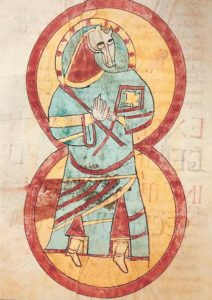The Schoenberg Database of Manuscripts

Le site web de The Penn Library de l’Université de Pennsylvania abrite désormais la base de données de Lawrence J. Schoenberg, véritable trésor bibliographique. Elle donne ainsi accès à plusieurs milliers d’entrées, manuscrits écrits avant 1600, passés en ventes publiques ou par des libraires spécialisés.
“The Schoenberg Database of Manuscripts encompasses more than 60,000 searchable entries of manuscripts written before 1600 and consisting of five or more leaves. This database is intended to be a powerful tool in :
– Locating and identifying information about particular manuscripts.
– Establishing the history and provenance of manuscripts.
– Aggregating descriptive information about specific classes or types of manuscripts.
It includes bibliographic information culled from approximately 4,000 catalogues issued by 400 dealers and auction houses since the early nineteenth century. This data is supplemented by entries from inventories and catalogues of private and institutional libraries. With twenty-nine searchable fields, it provides broad access to manuscripts through a range of discrete descriptive (i.e., vendor, catalogue name or number, item number, price, etc.) and physical (leaves, size, illuminations, etc.) properties. Multiple references to the same manuscript are cross-referenced to facilitate the tracking of individual manuscripts. The database is updated and augmented periodically on an ongoing basis.”
Source :
Michael T. Ryan, Director
Rare Book and Manuscript Library
Van Pelt-Dietrich Library
University of Pennsylvania
Digital Scriptorium
”The Digital Scriptorium is an image database of medieval and renaissance manuscripts, intended to unite scattered resources from many institutions into an international tool for teaching and scholarly research.
Medieval and renaissance manuscripts lie at the core of the work of scholars in a great number of fields: medievalists from many disciplines, classicists for the transmission of classical texts, art historians, musicologists, codicologists, paleographers, diplomatists, to begin to name the categories. The Digital Scriptorium looks to the needs of this very diverse community, and to the limited resources of libraries; it bridges the gap by means of extensive rather than intensive cataloguing, often based on legacy data, and sample imaging.”
Le remarquable projet initié par la Bancroft Library de l’Université de Berkeley porte actuellement sur un catalogue de plus de 5300 manuscrits soit environ 24300 images numérisées. Cette base de données couvre des documents du Moyen Age et de la Renaissance provenant des prestigieuses bibliothèques d’Austin (Univ. du Texas), Baltimore (Johns Hopkins), Berkeley (UC & affil.), Columbia (Univ. du Missouri), New York (Columbia & affil., Jewish Theological Sem., New York Public Library), et San Marino (Huntington Library). D’autres établissements vont intégrer cette base (Philadelphia, Free Library of Philadelphia, par exemple). Il va s’en dire que le médiéviste trouvera là un instrument remarquable car on connait assez la richesse de ces diffèrents dépôts.
Chaque description de manuscrit (reliure, provenance, bibliographie, etc) est accompagnée de plusieurs images de très bonne qualité visibles en trois formats. La base est consultable à partir de nombreux critères.
Le site donne également accès au Guide to Medieval and Renaissance manuscripts in the Huntington Library [En ligne] qui en fait est un vrai catalogue en mode texte (index auteurs, copistes, etc) de cette très riche bibliothèque.
Managing Director :
Consuelo W. Dutschke, Ph.D.
Curator, Medieval and Renaissance Manuscripts. Rare Book and Manuscript Library
Columbia University
535 W. 114th Street. New York NY 10027
tel: 212-854-4139. fax: 212-854-1365
email: cwd3@columbia.edu
Sources : site de Digital Scriptorium [En ligne]
Tablettes à écrire
Tabula rasa … (faire table rase) … l’expression – dit-on – était employée lorsqu’on lissait la cire d’une tablette à écrire pour en effacer le texte.

Pompéï. Ier s.
Ces tablettes en usage depuis l’Antiquité furent encore utilisées tout au long du Moyen Age.
Exemples, ces magnifiques ensembles de fabrication française acquis dernièrement par la Bibliothèque royale de Belgique :
KBR, ms. IV 1277 & 1278, avec leur étui d’origine en cuir bouilli, XIVe s.

ou celles – superbes – présentées par le Metropolitan Museum of Art de New-York :

Tablettes à écrire avec scènes de la Passion, ca. 1300–1320 (France ou Allemagne). Ivoire d’éléphant, polychrome, or. 73 x 40 x 23 mm.
(c) The Jack and Belle Linsky Collection, 1982 (1982.60.399)
On utilisait régulièrement de telles tablettes en bois de buis, buxa cerata, dont Isidore de Séville vente la robustesse et la facilité d’utilisation.
\”A côté de ces buxeae, des exemplaires plus soignés existaient, faits d’argent doré ou d’ivoire : tabulae de ebore, ex ebore, tabulae eburnae, codices eborei) expressions rencontrées chez saint Augustin ou le moine de Saint-Gall Ekkehard. Enfin, sous la plume de Raoul Glaber et bien d’autres auteurs (Pline l’Ancien, Sidoine Apollinaire, etc..) , on trouve le terme pugillares, pugillaris (de pugno : le poing, qui tient l’instrument), dans l’expression pugillares tabellae, pugillas ceras. Les tablettes étaient, le plus souvent, au moins doubles, formant ainsi diptyques, triptyques, etc., car un côté se refermait pour protéger l’autre qui servait à l’écriture, jusqu’à des livres entiers .\”

(c) Paris, Bibliothèque Sainte-Geneviève, ms 553, f. 105.
Sources
Paris BnF: L’aventure des écritures [En ligne]
Vindolanda writing tablets [En ligne]
Metropolitan Museum [En ligne]
Wikipedia [En ligne]
Bibliographie
Elisabeth Lalou (éd.), Les tablettes à écrire, de l’Antiquité à l’époque moderne: Colloque International du CNRS, Paris, Turnhout, Brepols, 1992 (Bibliologia 12).
Élisabeth Lalou, Le support de cire [annexe à la séance du 3 novembre 2005 consacrée aux Matériaux de l’écrit], dans Le manuscrit dans tous ses états, cycle thématique 2005-2006 de l’IRHT, S. Fellous, C. Heid, M.-H. Jullien, T. Buquet, éds., Paris, IRHT, 2006 (Ædilis, Actes, 12) [En ligne]
Élisabeth Lalou, Les tablettes de cire médiévales : support, surface [intervention du 7 mars 2002], dans Les matériaux du livre médiéval, séminaire de recherche de l’IRHT, M. Zerdoun, dir., Paris, IRHT, 2005 (Ædilis, Actes, 8) [En ligne]
W. H. Forsyth, French Medieval Writing Tablet, dans le Metropolitan Museum Bulletin, 33, p. 259-60.
F. W. Robinson, Notes on a French Gothic Writing Tablet, dans le Detroit Institute Bulletin, 22, p. 84-7.
Marc Smith, De la cire au papyrus, de la cire au papier : deux mutations de l’écriture ?, dans la Gazette du livre médiéval, 43, 2003, p. 1-13.
Tablettes découvertes à York par une équipe d’archéologues, et conservant quelques lignes en cursiva Anglicana ( XIVe s.) : The Role of the Wax Tablet in Medieval Literacy : A reconsideration in light of a recent find from York, par Michelle P. Brown, Journal of the British Library, volume 20, n°.1, 1994.


Parmi les préceptes de la Règle de saint Benoît , cap. 55 :
\”et ut hoc vitium peculiaris radicitus amputetur, dentur al abbate omnia quae sunt necessaria, id est cuculla, tunica, pedules, caligas, bracile, cultellum, graphium, acum, mappula, tabulas …\”.
Pour plus d’informations
voir le site du Dr Dianne Tillotson : Medieval writing.
St Laurentius digital manuscript library

La Bibliothèque universitaire de Lund (Suède) met en ligne plusieurs dizaines de manuscrits numérisés dont plusieurs proviennent de France, avec description précise et bibliographie. A remarquer le ms 38, Bréviaire à l’usage de Saint-Julien de Tours (XVe s., 138 f., 175 x 120 mm), portant ex-libris au f. 1r : Breviarium ad usum monasterii S. Juliani Turonensis Congr. Sti Mauri.
\”Other parts of the collection have come to the library through donations, acquisitions and testaments. Here are books by Classical authors like Cicero and Virgil, by post-classical writers like Boethius and by medieval theologians like Thomas Aquinas and Bonaventure. Here are the divine revelations of the Swedish 14th century saint Bridget, Danish and Swedish law texts as well as a Faroese manuscript with the so called Seydhabrevidh, a famous letter on sheep husbandry. We also find a copy of the Legenda Aurea, a collection of saints’ lives, of accounts of events in the lives of Christ and of the Virgin Mary and of information about holy days, by Jacobus de Voragine, very popular during the Middle Ages and a few copies of the medieval bestseller, the Book of Hours. The famous so called Lundse liederen, a fragment of a Dutch \”Minnesänger\” of the 13th century is also part of the collection. Deposited at the University Library by the Institute of Astronomy in Lund are several astronomical treatises, about the movements of the planets with descriptions of instruments with movable, threedimensional plans and diagrams. A few manuscripts are in other languages than Latin: Greek, Russian, Dutch, German, French apart from the Nordic already mentioned…
Contact :
UB Helgonabacken
Handskriftssektionen
Box 3
221 00 LUND
fax: 046-222 36 90
e-mail: handskrift@lub.lu.se
Source : site [En ligne]
Pages
Auteur du blog : Jean-Luc DEUFFIC

Commentaires recents
- dans Le livre d’heures et de raison de Maximilien Turpin, conseiller à la Gouvernance de Lille ( † 1704)
- dans Un ami nous a quitté: Gwenaël Le Duc (12 octobre 1951- 24 décembre 2006)
- dans René de Chasteaubriant (+ ca 1500), chevalier pèlerin pour la Terre Sainte, comte de Guazava au royaume de Fez
- dans René de Chasteaubriant (+ ca 1500), chevalier pèlerin pour la Terre Sainte, comte de Guazava au royaume de Fez
- dans Le «Maître du Policratique de Charles V» : un enlumineur breton ?
Visites depuis 10/03/2020
- 7
- 49
- 707



